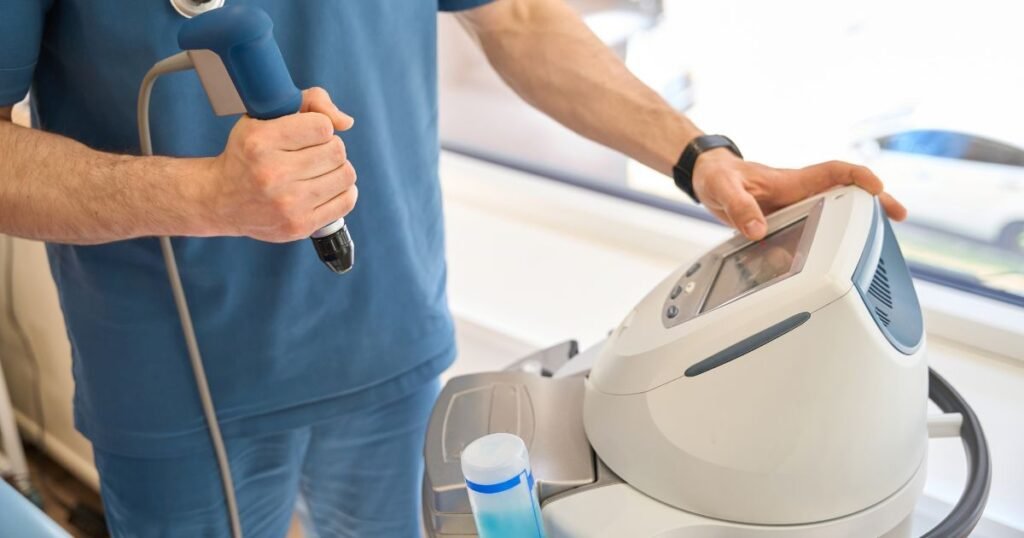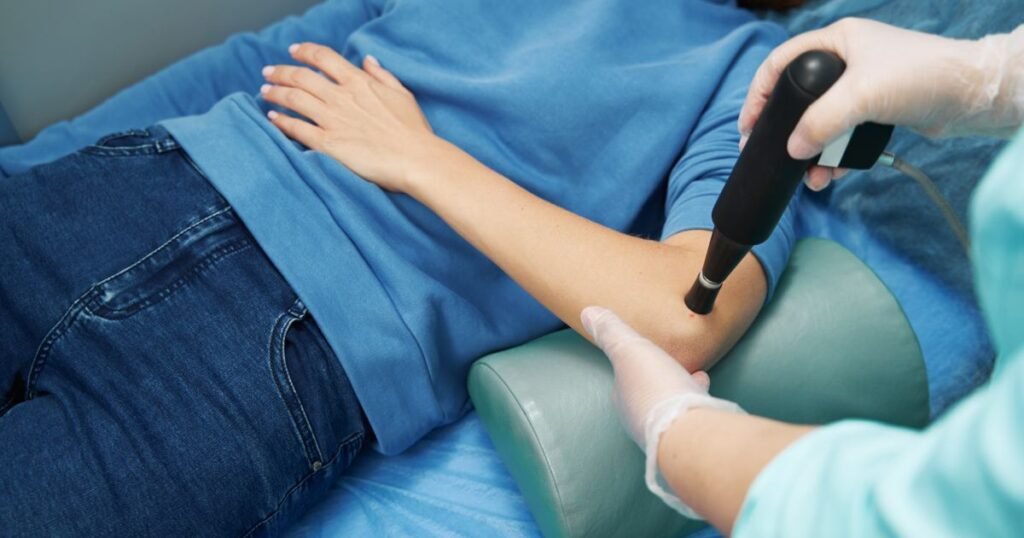
You ever feel like you’ve tried everything: ice, stretching, massage, rest, and that one stubborn pain just won’t go away? It’s there when you wake up, it lingers through your workday, and it laughs at your foam roller. That’s exactly the kind of persistent pain that often leads people to ask, what is shockwave therapy? And more importantly, could it finally be the answer?
Now, the word “shockwave” can throw people off. Sounds intense, right? Like something you’d see in a sci-fi movie or a heavy EDM track. But in the physio world, shockwave is surprisingly simple and surprisingly effective.
It’s a treatment that uses high-energy acoustic waves to target deep tissues and break up the cycle of inflammation, tightness, and delayed healing. It doesn’t involve needles. Or drugs. Or downtime. Most people stumble on Shockwave after everything else has failed. But it’s not a last-ditch effort, it’s just not the first thing folks usually hear about. And that’s kind of a shame, because when it works, it works.
So, let’s get into what is shockwave, how it helps, and whether it’s something worth exploring if you’re tired of chronic pain running the show.
What is Shockwave Therapy? Understanding the Basics
So, let’s clear one thing up right away, shockwave isn’t electricity zapping your muscles or anything weird like that. It’s sound (not the kind you hear, though). These are high-energy sound waves, focused and pulsed, sent directly into your tissue where stuff’s not healing the way it should.
The fancy term is “extracorporeal shockwave therapy,” but that’s a mouthful. Most people (and clinics) just say “shockwave”. Extracorporeal Shockwave Therapy is a well-researched method widely recognized for treating stubborn musculoskeletal injuries, and despite the intense name, it’s surprisingly straightforward and non-invasive
What it does is pretty wild: it jumpstarts the body’s repair process. Say you’ve got a tendon that’s inflamed and cranky (like in your elbow or heel) and nothing seems to help calm it down. Shockwave comes in, shakes things up (literally), boosts blood flow to that area, breaks up scar tissue, and wakes up cells that were basically on nap mode.
Think of it as hitting reset on stuck tissue.
It’s non-invasive; no cutting, no injections. You show up, you get a series of treatments (usually a few minutes long), and you’re back to your day. Some people feel it is working after just one session. For others, it takes a few more, depending on how deep or long the issue’s been hanging around. The tech itself has been around for a while, originally used to break down kidney stones, believe it or not, and now it’s showing up in physio clinics, massage settings, and even sports recovery centers.
And no, you don’t need to be a professional athlete to get it. That’s one of the biggest myths. More and more regular people: runners, desk workers, weekend warriors, are finding relief through shockwave, especially for chronic pain that’s been hanging around for months (or years).

Common Conditions Treated with Shockwave Therapy
Shockwave isn’t some one-trick thing. It’s used for a bunch of different pain issues, especially the ones that just won’t go away with rest, ice, or the “wait and hope” strategy. Here’s where it shines:
Plantar Fasciitis
This one’s a biggie. If you’ve ever stepped out of bed and felt like someone jammed a needle in your heel, yeah, that’s probably plantar fasciitis. It happens when the band of tissue running under your foot gets inflamed or micro-torn.
Shockwave helps by targeting that thick, irritated fascia with pulses that improve blood flow, kickstart healing, and loosen things up. It’s become one of the most recommended treatments for stubborn heel pain, especially when orthotics and stretching haven’t done the trick.
Tennis Elbow & Golfer’s Elbow
Even if you’ve never picked up a racket or club in your life, you can still get these. Repetitive strain, desk posture, lifting wrong; it all adds up. With tennis elbow, it’s the outer part of your elbow. Golfer’s elbow is on the inner side.
Shockwave works here by breaking down tight, painful tissue and helping the tendons repair. These injuries often creep up during seasonal activities, especially in spring, when the golf season has started and a lot of people return to the game a bit rusty. That’s usually when the elbow flares up the most.
Achilles Tendinopathy
That annoying pain at the back of your ankle? It’s usually your Achilles complaining, especially if you’re active, run a lot, or just landed on it wrong a few times. Chronic Achilles pain is notoriously tough to treat because of how poor blood flow is in that area.
Shockwave helps bring circulation back to the tissue and promotes regeneration. Over time, it can help reduce stiffness, swelling, and that raw “pulling” feeling when you try to move.
Calcific Tendonitis (Shoulder)
This one’s wild, calcium builds up inside the shoulder tendons, and it hurts. A lot. You can’t reach overhead without wincing, and it can mess with sleep big time.
Shockwave helps by breaking down those calcium deposits, or at least softening them up, so the body can reabsorb or clear them out. It also improves shoulder mobility by calming down inflammation and increasing tissue elasticity.
Hip, Back & Knee Pain (Chronic Cases)
Some pain doesn’t fit into a neat diagnosis, it’s just there, deep, dull, and always showing up when you sit, stand, or move a certain way. Shockwave isn’t magic, but it can be a solid option when pain hangs around and resists everything else. Especially for chronic hip tightness, low back flare-ups, or that knee that aches on stairs for no clear reason.
That wraps up the big hitters. If pain’s been sticking around longer than it should, and you’ve already done the massage/ice/brace circuit, shockwave might be worth a closer look.
How Shockwave Therapy Works with Massage and Rehabilitation
Shockwave on its own? Strong. But when you pair it with other treatments, that’s when it starts to shine.
In most real-life cases, people don’t just walk into a clinic, get one round of shockwave, and walk out feeling 100%. It can happen, sure. But for long-term healing and getting the body moving right again, layering it with other therapies just makes sense.
At Tonic Physiotherapy, this integrative approach is core to what they do, combining shockwave therapy, massage therapy, physiotherapy, and exercise rehab to create a full plan for recovery, not just quick fixes.
Massage Therapy
This one’s a natural match. Shockwave works on a deep, cellular level, but massage helps with blood flow, muscle relaxation, and getting rid of that lingering tightness. Especially after a shockwave session, when the tissue’s already loosened up a bit, massage can help flush out inflammation and reduce soreness.
Think of shockwave as the push that wakes the area up, and massage as the follow-up that helps it settle and realign. Tonic Physio’s registered massage therapists often pair sessions with shockwave to speed up recovery and reduce post-treatment discomfort.
Exercise Rehab & Mobility Work
Shockwave can break up scar tissue and stimulate healing, but if the surrounding muscles and joints aren’t doing their job, you’re just going to end up back in the same cycle.
That’s why so many therapists follow up shockwave with movement. Gentle strength work, mobility drills, sometimes resistance band stuff; just enough to reteach your body how to move right without overloading the area again.
It’s not about hitting the gym hard. It’s about smart, steady movement that rebuilds from the inside out.
Manual Therapy & Joint Mobilizations
Some injuries come with stiffness, like, actual mechanical restrictions in the joint or surrounding tissue. Manual therapy (hands-on techniques) can help reset that, and when paired with shockwave, it’s even more effective. The sound waves soften things, then manual work helps get movement back where it’s been stuck.
That’s why a combo approach works better than picking just one lane. No one treatment is the whole fix, they work better when they’re part of a plan that adjusts to how your body’s reacting each week.
What to Expect During Your First Shockwave Therapy Session
Let’s be real, the name alone sounds a little intense. Shockwave. Like something out of a sci-fi movie. But the actual session? Way less dramatic.
You walk in, chat with your physiotherapist about what’s been bothering you, and then get into a comfy position depending on where the issue is. No wires, no big machines. Just a small handheld device and a bit of gel on the skin.
That device sends high-energy pulses into the area, it kind of feels like someone is tapping or thudding deep into the muscle or tendon. Not always painful, but definitely not the same as a relaxing massage. If the area’s inflamed or really sensitive, yeah, it might sting a bit. But most people say it’s tolerable. More uncomfortable than painful.
And it’s quick – a session usually takes about 15 to 20 minutes. You’re not in there for an hour, and you’re not sore for days after. Sometimes there’s a bit of tenderness later that day, but it fades. A lot of people even walk out feeling looser — like the tension finally let go.
Most injuries need more than one session. Two or three for newer stuff. Five or six if it’s been bugging you for a while. It’s not a miracle fix, but it does speed things up, especially when nothing else has worked so far.
The whole vibe is less clinical than you might expect. Just a solid, focused treatment that does what it’s supposed to without dragging things out.

Who Should Try Shockwave and When to Expect Results
Shockwave therapy isn’t for everyone, but it’s a solid option when you’ve tried the usual stuff: rest, stretches, massage and the pain just won’t go away. It’s especially helpful for chronic issues like plantar fasciitis, tennis elbow, or that annoying shoulder pain that flares up when you lift your arm.
It works best for injuries that are past the fresh, inflamed stage, ones that have kind of settled in and become part of the background. On the flip side, it’s not ideal for nerve pain, active infections, or during pregnancy. And if you’re still dealing with swelling or acute pain, it might be a bit too much too soon.
So, how fast does it work? That depends. Some people feel better after one session. Others need a few before things loosen up. But usually by the third or fourth visit, there’s a shift and maybe less stiffness, or that deep ache starts to ease up. It’s not an overnight thing, but it often moves the needle faster than physio or massage alone.
And if you’re someone active: a runner, golfer, weekend warrior, shockwave can be a nice tool to throw into the mix when old injuries start creeping back in. Especially ones like golfer’s elbow.
Final Thoughts: Is It Worth Trying?
If you’ve been stuck with pain that just won’t back off, shockwave can be worth a shot. It’s not a miracle fix, but for a lot of people, it’s the thing that finally forwards the healing process along. Especially when the usual stuff isn’t helping it anymore.
The best part? You don’t need to commit to ten sessions right away. Most clinics start with a few and reassess. If it helps, great. If not, you move on. No pressure, no drama.
At the end of the day, it’s just another tool, but sometimes, the right tool makes all the difference.
